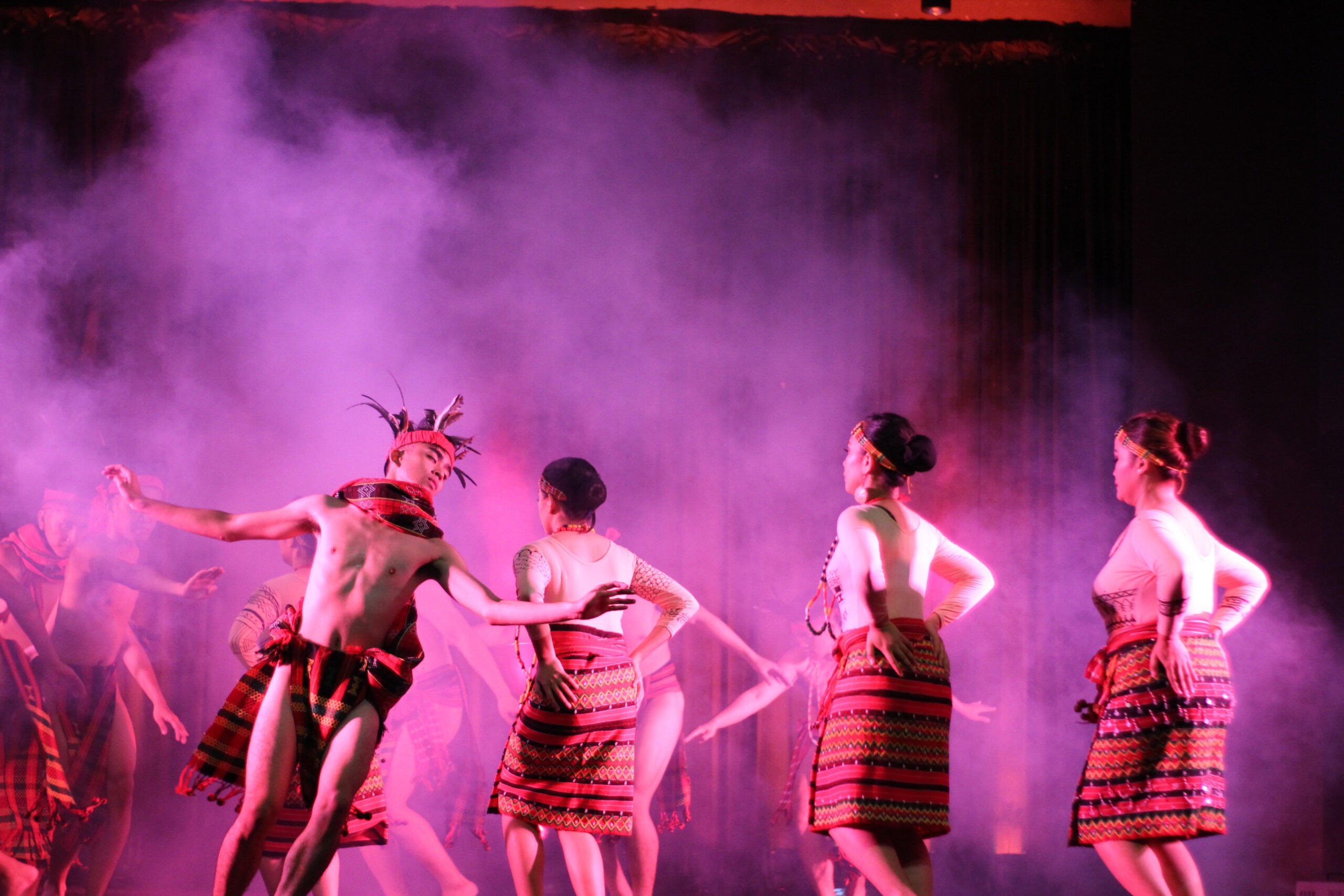PAG faces budget, scholarship cuts for AY 2021-2022
Special Report originally published in HF Volume 36 Issue 1
As the coronavirus disease (COVID-19) pandemic brought unprecedented hurdles to the financial state of the University, both the school administration and scholars were trying to make ends meet since the academic year (AY) 2020-2021. However, as the new AY began, making ends meet didn’t seem to be a feasible alternative anymore for some scholars – especially for members of the Performing Arts Group (PAG) who faced drastic cuts in their budget and scholarship funds for AY 2021-2022. With more than half of its P100,000 allocated funds reduced for the current AY, The HERALDO FILIPINO takes a closer look on how this affected their overall operations as internally-funded student organizations, and how making ends meet proved to be much more difficult to bear for some PAG members.
Budget and scholarship cuts
In an exclusive interview with The HERALDO FILIPINO, PAG officers revealed the sudden reduction when it comes to their yearly budget – from P100,000 in AY 2020-2021 to P35,000 per PAG organization for the current AY. PAG is composed of seven units, which includes the DLSU-D Chorale, DLSU-D Symphonic Band, La Salle Filipiniana Dance Company (LSFDC), Lasallian Pointes N’ Flexes (PNF), TEATRO Lasalliana, Lasallian Pop Band (LPB), and the Visual and Performing Arts Production Unit (VPAPU).
This means that every PAG organization was deducted by P65,000 from its previous budget – more than half of the P100,000 allocation that was offered in AY 2020-2021 and even during the pre-pandemic years. Under this P35,000 budget are the funds they will be needing for events and expenses of the organizations per year, in which they are required to host at least three (3) projects per semester. Scholarship budget, on the other hand, does not come from this allocation.
Aside from the budget decrease, the highest scholarship grant offered to PAG members was also reduced to P15,000 from the P20,000 in the previous AY. In AY 2019-2020, the highest scholarship grant for each PAG member is P25,000. This, however, depends on whether or not they will qualify within the scholarship criteria set by the Cultural Arts Office (CAO), which includes their attitude, academics, attendance and performance in the organization.
When asked how these organizations learned about the budget reduction, PAG Chairman and VPAPU President Michaela ‘Mikee’ Tamonan said they were informed on the changes by CAO Coordinator Joel Refuerzo on September 11. According to Refuerzo, the school administration cannot sustain the P100,000 budget for each PAG unit for this AY.
“Nauna kay dad, kay Sir Joel Refuerzo na nagpa-meeting siya sa amin regarding the budget so sinabi niya doon lahat, in-explain kung bakit kailangan namin mag-reduce, kailangan naming magbago ng budget for the scholarship, as well as for the events,” Tamonan shared.
Refuerzo confirmed this in a follow-up interview with The HERALDO FILIPINO, where he said that a resolution agreed upon by PAG officers had been passed, thus reducing their yearly funds to P35,000. Office of Student Services (OSS) Dean Domingo Reblora Jr. also affirmed these statements, saying that their office adopted the proposal submitted by the PAG officers.
“As part of the decision-making process, we evaluated the budget performance of each PAG last Academic Year when virtual events and activities started and in effect, lessen the expenses as compared to face-to-face setting where a lot of expenses were taken into consideration such as venue rentals, sounds and lights rentals, transportation, meals etc. The SDAO Director and the OSS Dean were also consulted about this matter,” the CAO Coordinator said.
Upon the officers’ consultation with Refuerzo, Tamonan shared that the reduction in the number of enrollees was one of the factors as to why the University cannot sustain its usual budget allocation for PAG organizations. Both Refuerzo and Reblora also cited reasons for the budget reduction, mentioning how the University had around 16,000 enrollees in pre-pandemic years compared to more than P8,000 students in the current AY.
In a data released to The HERALDO FILIPINO from the Office of the University Registrar (OUR), DLSU-D has actually recorded a 23.75 percent increase in its enrollment turnout for the first semester of AY 2021-2022, from 8,135 students in the second semester of AY 2020-2021 to the 10,067 students enrolled for the current semester. However, only 8,405 enrollees were recorded in undergraduate programs.
In separate interviews, CAO, OSS and the Office of Vice Chancellor for Academics and Research (OVCAR) also cited the difficulty in tuition fee payment collection as one of the reasons behind the budget and scholarship reduction for AY 2021-2022.
“Tuition fee collection has been challenging since the pandemic began. This resulted in the university cutting on all its expenses to survive,” VCAR Dr. Marco Saez said in an interview.
When it comes to how the P35,000 annual budget was finalized, Tamonan noted that there was no specified range of choices provided by the administration as to how much from its P100,000 budget can be reduced. This means that PAG officers, through its organization presidents, have taken it upon themselves on how they will decide the budget, considering the sole condition that the administration cannot sustain its previously allocated fund. Sitting through a series of meetings with each officer and Refuerzo, PAG officers then unanimously voted for the P35,000 allocation.
“Kapag tinaasan pa namin yung (budget for) scholarship, bababa pa lalo ‘yung P35,000, which is magiging very hard na sa amin yun,” said Tamonan as she explained how they came up with the 35,000 budget proposal.
Apart from considering scholarships, PAG officers have also taken account of the event expenses and honorarium given to their advisers. Since the start of the pandemic, PAG advisers were released from contract due to the University’s cost-cutting measures. It was only this AY that they were reinstated as advisers – not as official trainers with annual contracts, but only given with monthly honorarium.
In an interview, Reblora noted that trainers still receive the same amount of salary from pre-pandemic years, explaining that only official contracts are removed for the AY 2021-2022.
“It was the best advice to us that we should not reinstate yet the contract, but they will be informed that this is the salary or the stipend they will receive, are they amenable with that? And then we do it by PRF while the situation is still very fluid,” said the OSS Dean, who raised that contracts are delicate matters to venture given the current financial status of the University.

From top left to right: Tamonan of VPAPU, Mejico of The HERALDO FILIPINO, Corpuz of Teatro Lasalliana; From bottom left to right: Pedrosa of DLSU-D Chorale, Pacayra of LSFDC, Abug of LPB in an online interview via Zoom.
CAO Trust Fund
Meanwhile, PAG officers also disclosed that unused budgets left from every AY directly proceeds to the trust fund of the CAO per year. According to them, the trust fund was commonly used for the salary of PAG advisers and as contingency funds of these student organizations. More so, PAG officers stated that they have no access to the financial report of the CAO Trust Fund even before the pandemic.
“Before pandemic, CAO Trust fund was created mainly for PAG Activities such as Workshops, Leadership Training, Team building Activities, Minor and Major Productions, Recruitment, PAG General Assemblies, Outreach Programs, Mid-year workshops, various competitions, seminars and other expenses relative to the mentioned activities like meals, rentals for venue, transportation, representations, sounds and lights, costumes, equipment, musical instruments, props etc,” Refuerzo clarified when asked about the specific purposes of the trust fund.
However, the officers said that the scholarship budget for PAG members now comes from the CAO Trust Fund, which in previous AY is normally credited to the funds of the Student Development and Activities Office (SDAO).
Refuerzo confirmed this in the interview who shared that “major adjustments on the allocation and utilization of the CAO Trust fund happened when we were informed that the Scholarship Grants of our PAG members will be credited to CAO TF instead of SDAO budget (General Funds).”
When asked about the reason behind this change, SDAO Director Eric Vargas admitted that this was also due to the financial limitations of the University during the pandemic.
“Undeniably, the University is not exempted from the negative effects of the pandemic on its financial status. The decline in enrollees, payment collection from students whose parents’ jobs are affected also by the pandemic, and other related reasons forced the University to find creative ways to keep its operations afloat despite the financial challenges,” Vargas raised.
While the SDAO director is hopeful that the scholarship funds will be credited to their office in AY 2022-2023, Vargas said this still depends on DLSU-D’s financial situation by next AY.
Impact on PAG members
Given the smaller budget allocation to PAG groups this AY, PAG officers expressed how this has affected most of its members – with some having to leave the organization for either of the two reasons: they cannot enroll for the semester or they need to focus on juggling work and academics.
“Alam naman natin na hindi naman ganoon kalaki ‘yung nabababa sa tuition fee natin. So ang hassle pa rin kasi ang laki pa rin yung binabayaran ng student. Kaya umabot sa point na hindi na nakakapag-enroll at nababawasan pa ang members,” DLSU-D Symphonic Band President Jane Perez stated as she shared that one of their members wasn’t able to enroll upon knowing the reduced scholarship grant.
This is the same case for some members of LPB and LSDFDC who had to quit the organization to focus on their responsibilities as working students.
Meanwhile, DLSU-D Chorale President Marla Pedrosa admitted how hard it was to inform their members on the status of scholarship grants, causing some losing motivation to continue working for the organization.
“Sobrang bigat nya ibaba (sa members) na shocks ang dami na nating iniisip, tapos bababa pa to. Kasi ito na lang yung isa pinakamalaking help na binibigay sa parents natin tapos bababa pa siya,” said Pedrosa.


Shift to low-cost projects
Aside from the effects on its members, PAG officers also noted that they were left with no choice but to adjust the standards of their projects and productions to maximize the P35,000 budget for each organization.
For Teatro Lasalliana who usually holds major theater productions in pre-pandemic years, no big productions have been held since the spike of the pandemic following the restrictions brought by COVID-19. Even though the organization wants to host virtual shows, Teatro Lasalliana President Zachary Mace Corpuz said this would not be possible with PAG’s current yearly budget, considering that expenses for their normal productions cost at least P300,000 before the pandemic.
LPB, DLSU-D Symphonic Band, and PNF shared a similar plight on adjustments, saying that they are sometimes forced to lower the standards of their projects to consider the organization’s tight budget.
“For instance, if we want to conduct concerts and other events, we can only get voluntary performers who would give their talents for free instead of hiring performers with talent fees. We also resort to asking our members or partnering with other orgs for music edit music and videos,” PNF President Jasmyn Jedd Reyes shared.
“Worst case scenario, minsan kahit gusto mo magkaroon ng magandang event para sa lahat ng students, sige dito na lang within the organization na lang namin para at least mas tipid,” Perez of Symphonic Band also expressed.
This same goes for the La Salle Filipiniana Dance Company (LFSDC) who decided to focus on internal programs for the first semester of AY 2021-2022 to save their funds. However, even internal programs are also affected by the small budget allocation, as the group’s Executive Vice President (EVP) for Internal Affairs Trishia Pacayra raised their experience on proposing a P5,000 budget for their General Assembly (GA) this semester. According to Pacayra, they had to remove portions of their event as their proposed funds were reduced to P3,000.
“Nakaka-frustrate lang na hindi mo ma-achieve yung initial plans mo kasi ito nga yung factor na kailangan mong i-consider yung budget na minimized na minimized na talaga,” the LFDC representative said.
“With regards kay Sir Joel […] ang tinitingnan niya talaga is yung budget. Since ganoon yung binibigay niyang response sa budget, kami na yung nag-iinterpret noon. More of maging creative pa in creating projects, programs. Or more of practicality talaga, kailangan gawin pang mas maliit yung event para mas maximize talaga to its best yung approved na budget,” Abug of LPB further clarified.
As organizations continue to rely on a limited budget, PAG officers recalled some instances where they had to shoulder the group’s expenses using their own pocket money to push through their plans. For instance in PNF, Reyes had to personally use her own money to purchase a licensed Zoom account for their dance classes due to the long process for budget approval.
On the other hand, LPB’s Abug mentioned that in their organization, a P50 membership fee is collected per semester to at least have contingency funds aside from its P35,000 yearly budget. In VPAPU, Tamonan stated that they had to think of more creative ways on how to hold their major events, such as depending mainly on sponsorships.
Hopes, appeals for next AY
Given the current state of PAG budget and scholarships, PAG officers raised a common appeal of calling for transparency from the University regarding the fund allocation for PAG organizations.
“Sana meron maging two-way communication, yun nga yung transparency, and yung aid na need na kinakailangan kasi maraming naapektuhan hindi lang yung organization, pati yung mga members,” Pacayra of LFSDC stressed.
Pedrosa of DLSU-D Chorale then asked the administration if they can secure a copy of the financial report of the CAO Trust Fund, so they know where their funds are fully used.
Apart from transparency concerns, the officers also appealed to the administration if they can be allowed to utilize the campus for their rehearsals and productions next semester and allow them to maximize the organization’s instruments inside the University.
When asked if this would be possible, OSS Dean Reblora mentioned that his office and SDAO have already drafted guidelines to allow student organizations to maximize their facilities next semester under limited conditions.
“Very limited pa rin siya Lance (HF) eh, because we are at the mercy of IATF and GSO […] tapos we also have to consider the existing offices that they have,” he added.
Encapsulating the appeals of PAG organizations on their current situation, the VPAPU President and PAG Chairman emphasized that demanding these appeals would not only be for their own good as officers, but more so for the welfare of its members.
“Kami kasi yung haharap at haharap sa mga members. So sana ganun (maging transparent) Matagal na siyang problem na ganito, yung transparency. Alam yan ng COPS (Council of Presidents) at ng ibang members ng PAG kung gaano kami ka-eager for transparency on everything,” Tamonan said.
***
While the pandemic continues to bring troubles for everyone, making ends meet seems to be the most viable option to survive. However, it remains undeniable how these adjustments made the unstable situation even more destabilizing and unbearable on the side of some students and scholars – with some having to run twice and more just to get half as far of their needs. Along with the hopes of better days for the school to better serve its students, it is within everyone’s hopes too that PAG members would someday regain the prestige and privileges they once had – for all the prestige they brought and continue to bring in the University for years and beyond.





